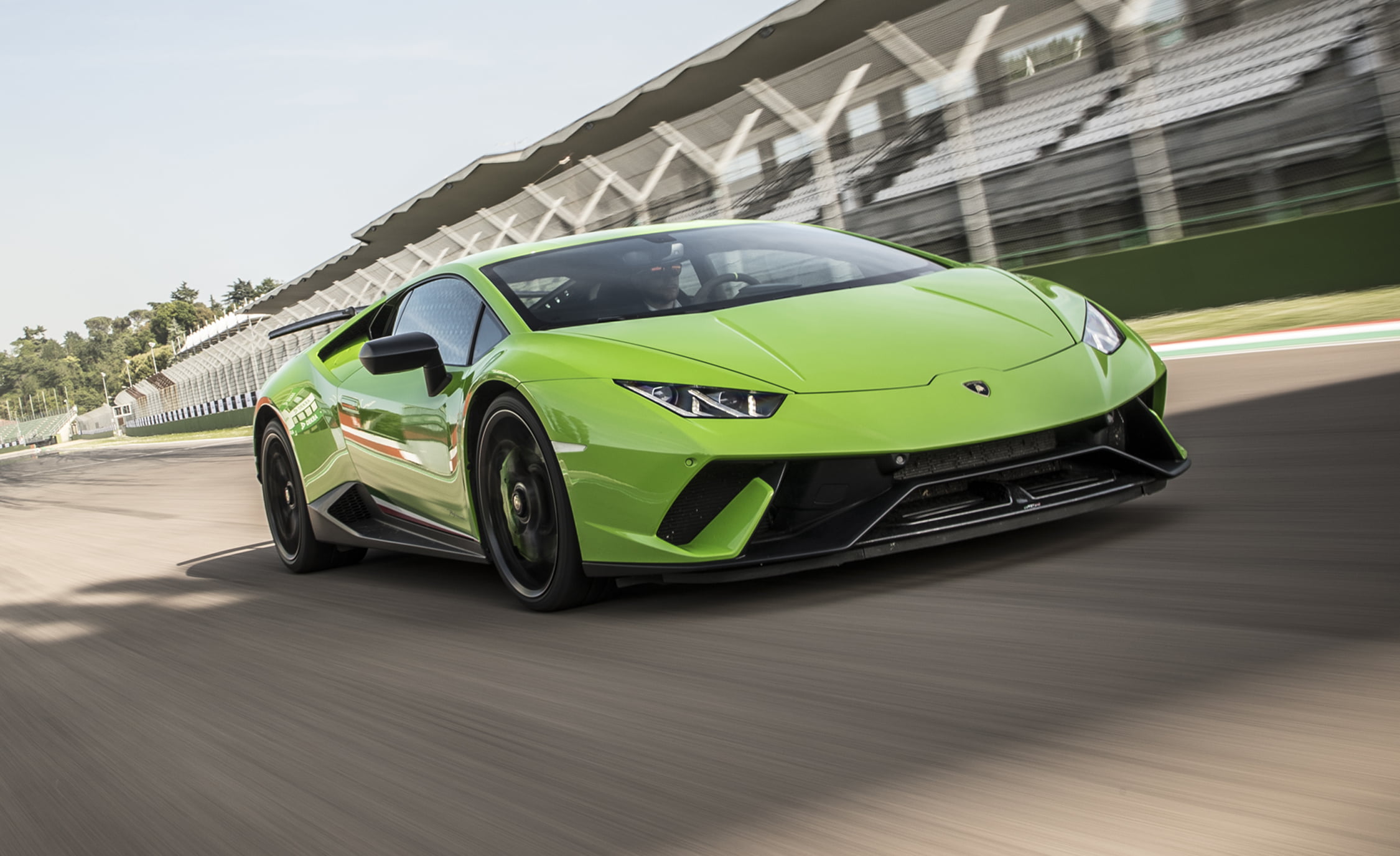
For those of us who have been interested in fast cars since the 1970s, the lingering impression remains that Lamborghinis are long on looks and big, loud engines and short on sophistication, technology, and refinement. This started changing in 1998 after Audi purchased Lamborghini, and the transition accelerated with the introduction of the Gallardo about five years later. With every subsequent new car, Lamborghini has gotten more serious about offering a more complete set of automotive virtues. The most impressive one yet is the new Huracán Performante.
As the name suggests, this is the high-performance version of the regular Huracán, as if such a concept makes sense for a car that can turn the quarter-mile in 10.4 seconds at 135 mph in standard form. But the Performante pulls it off, establishing a new production-car record of 6 minutes, 52.1 seconds at the Nürburgring Nordschleife. Yes, a Lamborghini test driver was behind the wheel and the car was equipped with supersticky Pirelli P Zero Trofeo R tires. But still, that’s some 35 seconds quicker than a base Huracán’s lap time.

A 360-Degree Approach
Achieving such a massive improvement required upgrades in several areas of the car. Lamborghini R&D boss Maurizio Reggiani calls this a 360-degree approach to performance. For the Performante, this means more power but also weight reduction, suspension improvements, and the addition of an innovative aerodynamic package.
The extra power was enabled by fitting new titanium intake valves. Their lighter weight made possible a hotter intake-camshaft profile with greater duration and lift. Coupled with a freer-flowing exhaust system and a less restrictive air filter, the Performante engine makes 29 more ponies for a total of 631 at 8000 rpm—250 revs lower than the standard Huracán’s power peak. Peak torque increases by 30 lb-ft to 443 at an unchanged 6500 rpm. The changes make for a usefully fuller power curve above 4000 rpm.
A weight reduction of about 90 pounds makes this stronger engine’s life even easier. The kilos and grams were shaved by fitting more carbon-fiber parts on the Performante. These use Lamborghini’s patented Forged Composite technology, which uses inner and outer molds under pressure to create more complex and less expensive parts than traditional laminate construction. In place of the intricate woven fabric pattern of the traditional carbon-fiber parts, these instead resemble a black-and-gray version of tortoiseshell but still look terrific in their own way.
There’s also a redesigned stainless-steel exhaust system that uses simpler plumbing and a central outlet to save 22 pounds alone. Keep in mind that 90 pounds is the net reduction after the weight added by the new aerodynamic package.

While the tire-and-wheel sizes do not increase—about the same as a current Porsche 911 Carrera’s—the rubber escalates from standard Pirelli P Zeros to the track-oriented P Zero Corsa tires. And even stickier P Zero Trofeo Rs are available as an option.Reinforcing the chassis to match the additional thrust—the power-to-weight ratio is 7 percent better—the Performante gets 10 percent stiffer spring rates and thicker anti-roll bars to produce a 15 percent increase in roll stiffness. Recalibrated (optional) magnetorheological dampers match these stiffer components, as do suspension bushings that are 50 percent stiffer both axially and radially.
Finally, the Performante gets an aerodynamic package called ALA, which stands for Aerodinamica Lamborghini Attiva. The package adds a front splitter and a prominent rear wing to create as much as 770 pounds of downforce at 193 mph, greatly increasing high-speed grip.
The Attiva in the name means active, and the system can reduce its downforce—and associated drag—using some clever engineering. In front, a pair of grille flaps can open, relieving the air pressure above the splitter to greatly reduce drag and downforce.

This is a much simpler and lighter approach than using some sort of linkage to change the angle of the wing. It also allows side-to-side adjustments, as there is a separation in the middle of the wing’s cavity. So by stalling only one side of the wing, it’s possible to balance the vertical force on the rear tires during cornering.In the rear, the wing is hollow, as are its supporting struts, and there’s a series of slots on the underside of the wing that are open to its internal cavity. A pair of air scoops located in front of the struts are controlled by motorized flaps and can feed air into this hollow wing. When the flaps are shut, air flows over the wing conventionally, creating plenty of downforce at speed. However, when the flaps open, air flows into the wing and out through the slots, stalling the wing and reducing both downforce and drag.
Animated at Imola
We had a great opportunity to evaluate these changes at the Imola racetrack, near Lamborghini’s Sant’Agata Bolognese headquarters. Although the track has been reconfigured with several new chicanes since the accident that killed Ayrton Senna in 1994, it is still an extremely fast circuit, well suited to powerful cars.
With the ANIMA—Lamborghini-speak for driving-mode selector—set to the racetrack-oriented Corsa setting, the car is configured to have maximum downforce, the stiffest shock response, and heavier steering with a linear and faster ratio. Yes, a faster ratio. The Performante is available with Lamborghini Dynamic Steering, which allows changes in the steering ratio, not just the steering effort and feedback adjustments that have become typical in performance cars. In Corsa mode, too, the seven-speed dual-clutch automatic gearbox operates in full manual mode, banging hard shifts as you manipulate the large paddles on the steering column.

That redline is quite high for an engine with the V-10’s longish stroke and humble origins. It did, after all, evolved from Audi’s V-8 engine that launched for the 1990 model year, which in turn was derived from Volkswagen Golf powerplants going back to the 1970s. Despite these strands of low-born DNA, it’s a wonderfully satisfying engine with great charisma and no turbochargers to homogenize its intake and exhaust soundtracks.It’s a good thing that the paddles are large and easy to reach because the engine charges toward its redline so quickly that simply shifting before you bounce off the rev limiter requires concentration. But within a few laps, we’d learned exactly which frequency of the V-10’s bellicose roar signaled that we were approaching the 8500-rpm redline.
The carbon-ceramic brakes felt fully capable of coping with the engine’s power, and the enhanced suspension gave the car a planted and secure feel. The Performante turns in well, and despite having all-wheel drive, it’s the tail end that breaks free first. Within a few laps, we were seeing 170 mph on the longest straight and sliding the car through the tight chicanes as we used the curbing to straighten the car’s line. The Performante’s forgiving nature near its handling limit made its extreme performance accessible.
Ambling on the Avenue
Outside the confines of the track, we flicked the ANIMA to Strada, Italian for street, and happily trundled along through thick city traffic. The dynamic dampers are softer in this mode, and, while firm, the ride never felt harsh over the fairly smooth Italian roads. At the same time, steering effort is more moderate and the transmission operates in an automatic mode, shifting for itself smoothly and letting the aggressive engine loaf at low rpm, which it is perfectly glad to do.

Whether used as a track tool or a Sunday escape vehicle, the Huracán Performante satisfies and excels. And for those who still believe Lamborghinis are solely suited for turning heads on the street, the Performante is pretty good at that as well.The Performante comes standard with a minimally adjustable track-oriented seat, but buyers can also opt for the comfortable, highly adjustable standard seats. Forward visibility is excellent, the jet-fighter array of switches eventually makes sense, and you can appreciate showy touches such as the bright-red flip-up cover that protects the engine-start switch. The instrument cluster is a large TFT screen that is extensively reconfigurable to suit your whims. But the tachometer is somewhat hard to read, and—given how rapidly the engine accelerates—a head-up display would be a nice addition.
[“Source-caranddriver”]





